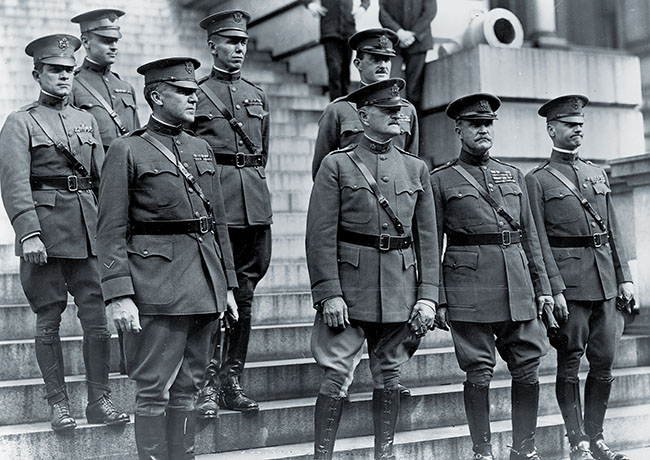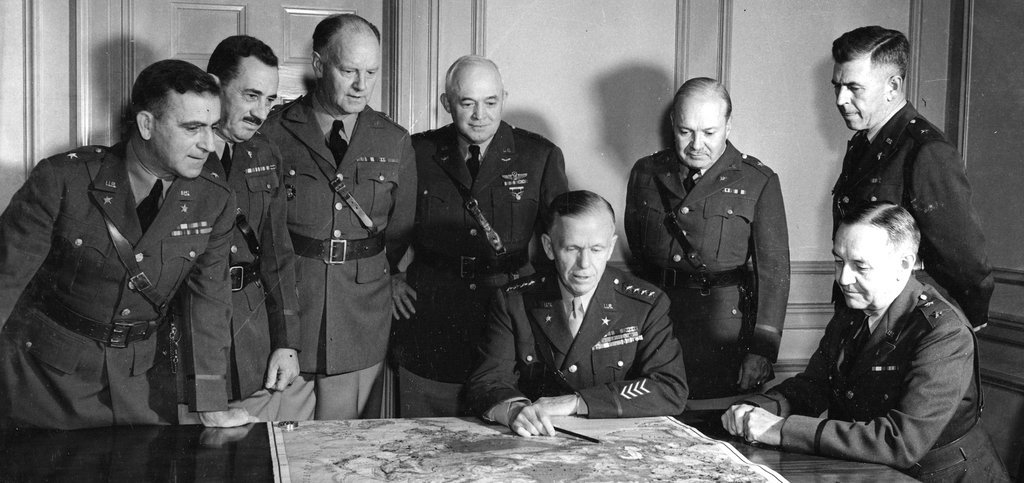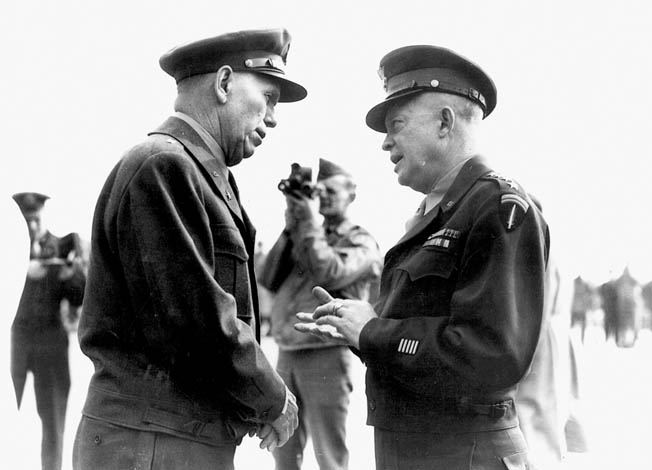By Michael J. Hennelly
 Many people today don’t remember George Marshall, but in the middle of the 20th century he was inescapable. A five-star general who later won the Nobel Peace Prize, Marshall was once described by President Harry S. Truman as the greatest soldier in American history. Other world figures agreed, and after World War II, the British Prime Minister Winston Churchill called Marshall the true organizer of Allied victory. After his retirement from public life, Marshall turned down many lucrative offers for his memoirs. In 1956, the historian Forrest Pogue began a thirty-year project of researching and writing a massive four-volume biography of Marshall. In the first volume (Education of a General, 1880-1939), Pogue provides a small anecdote from Marshall’s early life. This story serves as a diagnostic for one important aspect of leadership. Leaders are usually thought to be self-starters, and this story can serve any potential leader as a way of measuring their own level of individual initiative.
Many people today don’t remember George Marshall, but in the middle of the 20th century he was inescapable. A five-star general who later won the Nobel Peace Prize, Marshall was once described by President Harry S. Truman as the greatest soldier in American history. Other world figures agreed, and after World War II, the British Prime Minister Winston Churchill called Marshall the true organizer of Allied victory. After his retirement from public life, Marshall turned down many lucrative offers for his memoirs. In 1956, the historian Forrest Pogue began a thirty-year project of researching and writing a massive four-volume biography of Marshall. In the first volume (Education of a General, 1880-1939), Pogue provides a small anecdote from Marshall’s early life. This story serves as a diagnostic for one important aspect of leadership. Leaders are usually thought to be self-starters, and this story can serve any potential leader as a way of measuring their own level of individual initiative.
The year was 1901, and a young George Marshall was in his fourth and final year as a cadet at the Virginia Military Institute. He had discovered he had an aptitude for military life and desperately wanted to become an Army officer. His problem was that the Army had downsized in the wake of the Spanish-American War and was in the middle of a massive reorganization. In addition, unlike West Point cadets, because he was graduating from the Virginia Military Institute (VMI), Marshall was not guaranteed an Army commission upon graduation. Given this set of circumstances, what do you think he did? You have three choices:
He wrote to the War Department, made his wishes known and then sat at home and waited for a response.
Given the unfavorable circumstances, he chose another career path.
He traveled to Washington, D.C., got into the White House, walked in on the President of the United States and asked him for an Army commission.
If you were 21-year-old George Marshall, you chose option 3! Pogue’s biography is filled with similar examples of initiative that made Marshall’s life so memorable and present a variety of indelible leadership lessons derived from the life of one of America’s greatest soldiers.
LEADERSHIP LESSON 1: SPEAKING TRUTH TO POWER IS ONE THING. DISAGREEING WITH THE POWERFUL IS DIFFERENT AND USUALLY DANGEROUS.
In Speaking truth to power is an exercise that proceeds from the assumption that you might have more power than me, but you are clearly wrong and I am clearly right. Strategic choices are rarely so clear-cut, and reasonable people often disagree on the merits of a particular strategy. We know from history that conformity is safe and disagreeing with the powerful is risky. Interestingly, George Marshall’s career was studded with risky and non-conformist moves that challenged people in positions of power.
When America entered World War I in April 1917, Marshall was still a junior officer. America’s entry into the war was a chaotic and disorganized time for the U.S. Army and its leaders were under enormous pressure to quickly commit untrained and poorly equipped American soldiers into combat. Marshall began the war as a captain on the staff of the 1st Division responsible for operations and training. On 3 October 1917, General John J. Pershing, the commander of the American Expeditionary Force and one of the most famous soldiers in the world, showed up to observe training by units of the 1st Division. For a variety of reasons, Pershing was unhappy, and he forcefully expressed himself by criticizing the division commander in front of the entire division staff.

The staff of General John J. Pershing (front row, second from left) during the Great War in 1919. Pictured with Pershing is Fox Conner (front left) and George C. Marshall (back row third from left).
Marshall was convinced that General Pershing had formed an erroneous opinion of the combat readiness of the division and had unfairly judged Marshall’s commanding officer. He started to explain matters to Pershing, who impatiently turned away from him. The young Captain Marshall then grabbed the seasoned four-star general by the arm and forced Pershing to listen to his justifications. After Pershing left, the division staff assumed that Marshall would be relieved from his position. Instead, the opposite happened. In his future visits, Pershing sought out Marshall and after the war, Marshall ended up as Pershing’s aide.
Twenty years later, in the fall of 1938, the threat of war was growing once again in Europe, and President Franklin D. Roosevelt called a White House meeting with key members of his administration. He wanted to discuss his proposed defense plan, which primarily consisted of a rapid and dramatic expansion of American military airpower. Marshall had been the deputy Army Chief of Staff for less than one month and, as a relatively new one-star general, was one of the lowest ranking people in the President’s office that day. During the course of the meeting, President Roosevelt asked each attendee if they agreed with his proposal. All the attendees voiced agreement except Marshall who flatly (but respectfully) disagreed with President Roosevelt’s proposal. The other attendees noted that Marshall’s disagreement caused the President to become visibly startled and after the meeting adjourned, many of those present made it clear that they thought Marshall had effectively ended his career.
Five months later, in a move that completely surprised most of Washington, FDR asked Marshall to be the next Army Chief of Staff. These two episodes say a great deal about Marshall. In wartime, physical courage is the relatively common type of courage that causes many soldiers to risk their personal safety on the battlefield. In contrast, ethical courage is a much rarer type of courage- but this is what Marshall demonstrated when, as a junior officer, he chastised a far superior officer in public, and later in his career disagreed with a U.S. President simply because he cared so passionately about his duty.
LEADERSHIP LESSON 2: STRATEGIC LEADERS HAVE TO BE GOOD AT INTERACTING WITH FOLLOWERS BUT, MORE IMPORTANTLY, THEY HAVE TO BE GOOD AT INTERACTING WITH OTHER LEADERS.
A common theme in leadership literature is the importance of good relationships between leaders and followers. Leaders use effective communication to motivate followers and to ensure that team activity is aligned towards a common goal. An examination of Marshall’s career reveals a different skill demanded of great leaders - the ability to effectively communicate and work with other leaders. Working with other leaders is far different, and in some respects it is much more difficult than working with followers. Leaders and followers often comprise a single team sharing common values and goals. In contrast, groups of leaders come from different teams and frequently have divergent goals, priorities, and world views.
During World War II, Marshall spent a great deal of time persuading, informing, arguing, and negotiating with other leaders, including President Roosevelt, the British Prime Minister Winston Churchill, the British Chiefs of Staff as well as other American commanders such as Admiral Ernest King (the Chief of Naval Operations) and General Douglas MacArthur (commander of U.S. Forces in the southwest Pacific). Even if we only focus on the American team of strategic leaders, we see people who were marked by a surprisingly broad range of perspectives, goals, and priorities.
AN EXAMINATION OF MARSHALL’S CAREER REVEALS A DIFFERENT SKILL DEMANDED OF GREAT LEADERS - THE ABILITY TO EFFECTIVELY COMMUNICATE AND WORK WITH OTHER LEADERS.
The relationship between Roosevelt and Marshall eventually developed into a close and productive one, and stood in stark contrast to his relationship with General MacArthur. During the war, MacArthur was considered a hero who could help win the war by the American press and the American people. He was a charismatic, politically connected military commander, and he was convinced of two things: first, the war in the Pacific was more important than the war in Europe and, second, he should be the overall commander of U.S. forces in the Pacific theater. Marshall shared neither of MacArthur’s convictions. To add to the complexity of the relationship, MacArthur had been Superintendent of West Point when Marshall was only a major, and he had been Army Chief of Staff when Marshall was a lieutenant colonel. In the global context of World War II, MacArthur’s command of the southwest Pacific was a relatively small responsibility compared to Marshall’s role as the Chief of Staff of the Army. Yet, Marshall spent a great deal of time and effort to keep their relationship focused on the war effort.

General George C. Marshall, seated at center, with members of his general staff, November 1941 | Getty Images
Marshall employed at least two specific strategies in his relationship with MacArthur. The first was a strategy of statesmanship. One aspect of MacArthur’s wartime record is that he never set foot in the United States during World War II; in fact he was out of the country continuously from 1937 to 1951. If Marshall wanted to talk to MacArthur, he had to go to MacArthur. So, after accompanying FDR to Tehran, Iran in late 1943 (where the Americans met with Churchill, the Soviet leader Joseph Stalin, and their commanders), Marshall--the senior officer--took the long and hazardous trip halfway around the world (in a propeller driven aircraft) to meet MacArthur in the South Pacific and discuss wartime strategy. It was the only meeting of these two soldiers during the entire war and demonstrated Marshall’s statesman-like ability to manage personalities in pursuit of long-term goals.
Marshall also employed a bridging strategy during the war to improve the relationship between MacArthur and the leaders of the U.S. Navy. On a personal level, this bridging strategy required Marshall to maintain a delicate balance. He worked hard to have a productive relationship with Admiral King but he refused to tolerate King’s constant criticism of MacArthur. At one point in 1944, Marshall threatened to walk out of a JCS meeting unless King stopped criticizing MacArthur. At a strategic level, a modus vivendi was achieved between MacArthur and the Navy by giving each their own Pacific strategy. Admiral Nimitz owned the campaign that primarily consisted of the Pacific Fleet and U.S. Marines island hopping through the Central Pacific, while MacArthur owned the campaign that proceeded from Australia through New Guinea towards the Philippines. This approach to distributing military forces violated principles of war such as economy of effort and unity of command. It certainly mystified Churchill and the British chiefs, but it enabled the Americans to employ a war-winning strategy with the least amount of inter-service conflict.
LEADERSHIP LESSON 3: EMPOWERING OTHERS IS NOT A MODERN CONCEPT.
Throughout the war, Marshall made it clear he didn’t want subordinates who simply identified problems for him to solve. He wanted subordinates who identified problems, solved them, and then informed him of the results. One of the most vivid examples of this leadership philosophy occurred in 1946. Marshall had retired as Army Chief of Staff in November 1945, but President Truman immediately asked him to be his Special Ambassador to China. Truman wanted someone on the ground to mediate the war between the Chinese Communists and the Chinese Nationalists. Marshall’s understanding was that he had approval authority over all U.S. action in China so that he would have leverage in his interactions with Chinese Chairman Chiang Kai Shek and Communist Party leader Mao Zedong. Before leaving for China, Marshall handpicked Army Colonel James Davis to serve as his liaison officer in Washington.

General Marshall, right, visits with General Dwight D. Eisenhower in Paris following the liberation of the City of Light from Nazi occupation in August 1944.
One day, Davis learned the U.S. Treasury Department was planning to make a substantial loan to the Chinese Nationalist government, and he was aware that Marshall knew nothing of such a loan. After unsuccessfully dealing with the bureaucracy at the Treasury Department, Davis found himself in the office of the Secretary of the Treasury, Fred Vinson, telling him that he couldn’t make such a loan. Vinson was a powerful Washington politician who, in the following year, became Chief Justice of the Supreme Court, and he certainly wasn’t used to an army colonel telling him what he couldn’t do. Vinson held off on the loan, but he demanded to see Marshall upon his return to Washington. Marshall arrived at Vinson’s office with Colonel Davis and, and in no uncertain terms, he told Vinson that Davis had been absolutely correct in his actions. After the office call, Davis nervously asked Marshall if he had done the right thing in acting without orders. Marshall simply looked at him and said, “I never complained, did I?”
“I never complained, did I?” Consider the absolutely enormous amount of loyalty implicit in Marshall’s words and actions. Marshall clearly demonstrated that the exercise of empowerment is a complex mix of several different leadership qualities. Marshall was good at empowerment because he was good at identifying people who could effectively use the responsibility he gave them. One of Marshall’s best known attributes during his entire career was the time that he took to remember people, evaluate their performance, and constantly re-evaluate their potential as circumstances warranted. More importantly, Marshall knew that expecting subordinates to assume responsibility was a two-way street. It also required Marshall to support them; his biography provides numerous examples of this behavior.
CONCLUSION: MARSHALL’S RELEVANCE FOR 21ST CENTURY LEADERS
George Marshall wore an Army uniform for more than forty years, but he serves as a valuable and relevant example to leaders in any organization. Marshall clearly demonstrated that trust is a force multiplier for leaders for at least two different reasons. Trust in the vertical dimension of leadership means trust between leaders and followers. This type of trust is valuable because leaders never want to be the bottleneck through which all decisions have to flow. Think of the multitude of decisions that Marshall faced as he rapidly built and deployed an army of millions in World War II. The pace of military expansion was so quick that he was adding the equivalent of an entire pre-war Army to his force structure every month for more than four years. Having subordinates who trusted him and were willing to take the responsibility of making decisions greatly increased his span of control. But as Marshall’s example shows, empowering subordinates is not a simple undertaking. Empowerment is not done simply to make an employee feel more fulfilled; it is an effective technique that expands the capability of an organization to make and implement decisions. Empowering subordinates is a twofold process: first it implies the ability to identify those who can employ responsibility in an effective manner, and second it implies a need for the leader to relentlessly support the subordinates. Seen in this light, it doesn’t do any good to empower a bunch of loose cannons.
THE PACE OF MILITARY EXPANSION WAS SO QUICK THAT HE WAS ADDING THE EQUIVALENT OF AN ENTIRE PRE-WAR ARMY TO HIS FORCE STRUCTURE EVERY MONTH FOR MORE THAN FOUR YEARS.
Trust in the horizontal dimension of leadership means trust between leaders of different organizations. Consider the eight American and British military leaders who made up the Combined Chiefs of Staff during World War II (Leahy, Marshall, King, and Arnold for the Americans; and Brooke, Pound, Portal, and Ismay for the British). It is useful to spend time considering why Marshall became primus inter pares in this group. One reason is that everyone trusted Marshall. For example, the British might have strongly disagreed with some of Marshall’s ideas, but they never questioned his motives. Marshall was not perceived as self-serving or as a commander who only protected the interests of the U.S. Army. He clearly demonstrated to FDR in his first White House meeting that he was willing to risk his career to reject a faulty idea. His behavior earned the enduring trust of President Roosevelt and Prime Minister Churchill, and these relationships were strong enough to endure the fears of military defeat in the first years of the war as well as the pressures of impending victory in the last years of the war.
Today, organizational leaders face the same challenges Marshall faced as he developed and employed his unique type of leadership influence. His life demonstrates several truths about leadership. We learn that people are primarily responsible for their own leadership development. Throughout his career, Marshall made personal (and risky) choices that contributed to his image as a trusted leader. We also learn that his power as a leader was based on the twin foundations of competence and character. He worked his entire life to develop the ability to accurately evaluate people before empowering them. He also showed loyalty to those to whom he entrusted with great responsibility. As a result, while a world was at war and in its grim aftermath, Marshall gave inspiration, motivation, and guidance to millions.
No comments:
Post a Comment